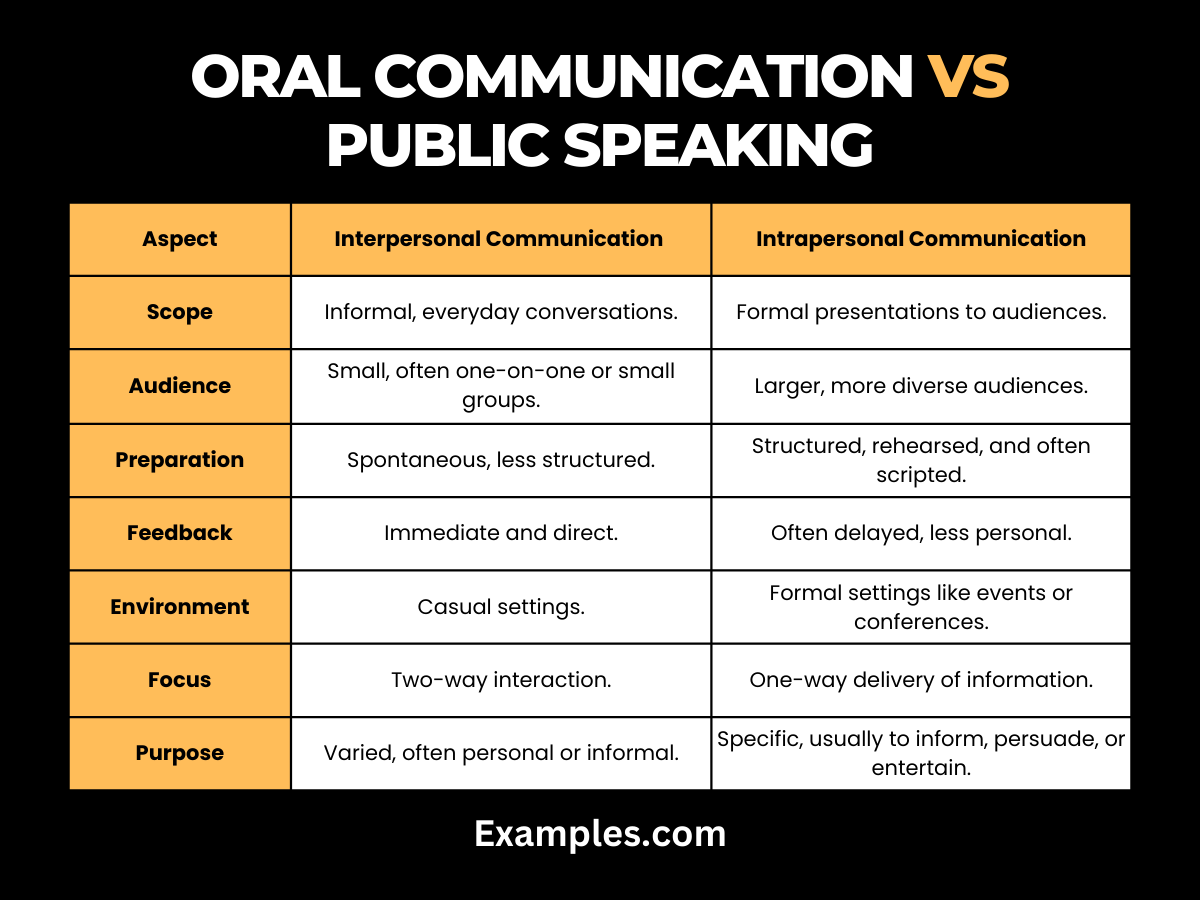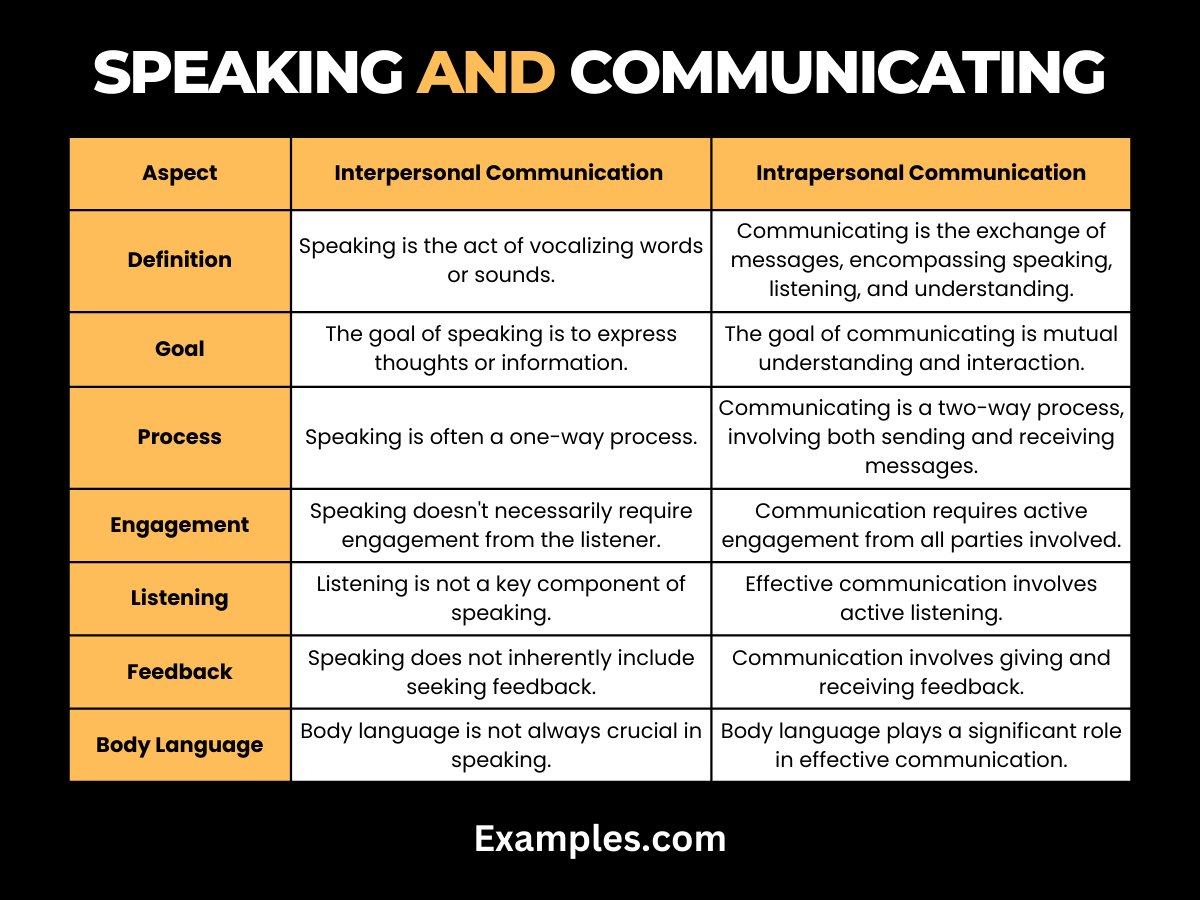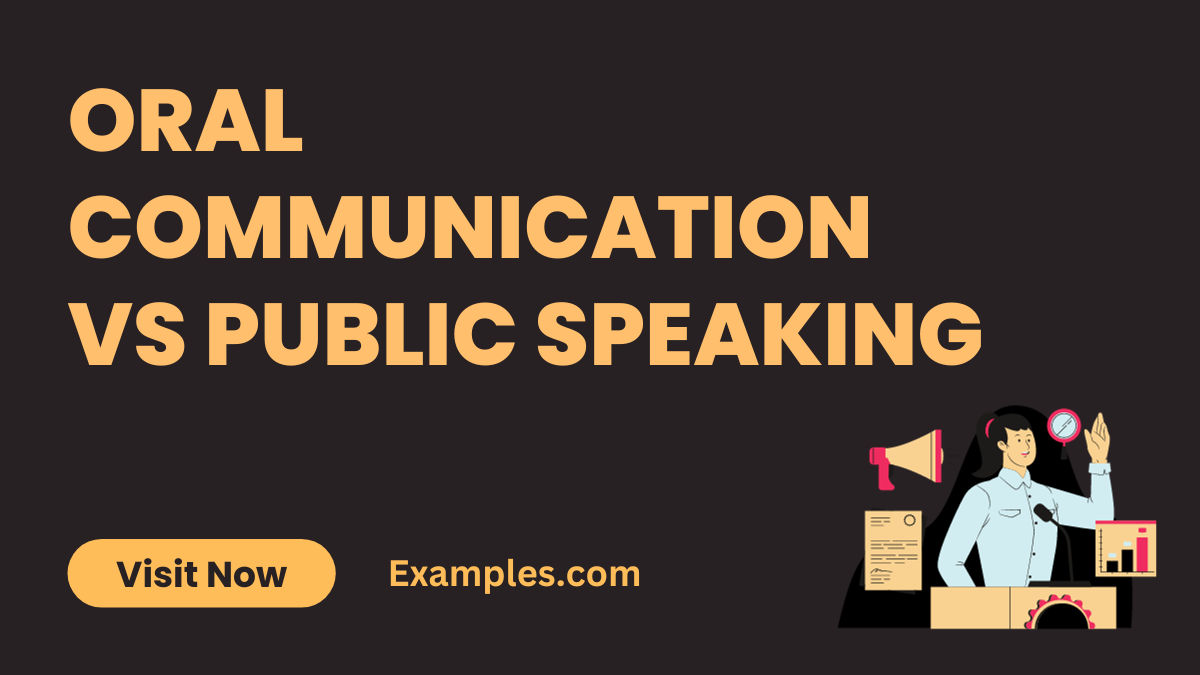Oral Communication vs Public Speaking – 9+ Examples
Dive into the dynamic world of Communication Skills with our comprehensive guide on Oral Communication vs Public Speaking. Whether you’re preparing for a boardroom presentation or a casual conversation, understanding these key differences is essential. This guide provides not just theoretical insights but practical examples and tips, helping you to tailor your communication approach effectively. Unravel the nuances of both styles and learn to use them to your advantage in various scenarios.
Differences between Oral Communication vs Public Speaking

| Aspect | Oral Communication | Public Speaking |
|---|---|---|
| Scope | Informal, everyday conversations. | Formal presentations to audiences. |
| Audience | Small, often one-on-one or small groups. | Larger, more diverse audiences. |
| Preparation | Spontaneous, less structured. | Structured, rehearsed, and often scripted. |
| Feedback | Immediate and direct. | Often delayed, less personal. |
| Environment | Casual settings. | Formal settings like events or conferences. |
| Focus | Two-way interaction. | One-way delivery of information. |
| Purpose | Varied, often personal or informal. | Specific, usually to inform, persuade, or entertain. |
| Support Material | Minimal or none. | Visual aids, slides, and other materials. |
| Body Language and Expression | Conversational, natural. | More controlled and deliberate. |
| Duration | Typically shorter and flexible. | Longer with a defined structure. |
10 Oral Communication Examples
Oral communication skills are essential for effective face-to-face interactions, whether in personal conversations or professional presentations. These skills involve a range of techniques, from clarity in speech to effective non-verbal cues, crucial for conveying your message effectively and engagingly. Below are 10 key oral communication skills, each illustrated with a unique example.
- Asking a question in class: This is a simple example of oral communication where a student engages in a direct, informal conversation with the teacher.
- Example : “Could you please explain the concept of photosynthesis again?”

- Delivering a graduation speech: This is public speaking, as it involves addressing a large audience in a formal setting.
- Example :“Today marks not just the culmination of our efforts but the beginning of our journey into the world.”
- Chatting with a colleague during a break: A casual instance of oral communication in the workplace.
- Example :“How was your weekend? I heard you went hiking.”
- Presenting a business proposal: This is public speaking, requiring preparation and a structured delivery to a group.
- Example :“Our strategy focuses on innovative solutions to drive customer engagement and sales.”
- Discussing dinner plans with family: A routine example of oral communication within a household.
- Example :“Should we try the new Italian restaurant tonight?”
- Giving a TED Talk: This is an example of public speaking, involving a prepared speech delivered to an audience.
- Example :“Today, I want to share with you a story that changed my perspective on life.”
- Ordering food at a restaurant: A common form of oral communication, involving a brief, informal exchange.
- Example :“I’ll have the grilled salmon with a side salad, please.”
- Conducting a workshop on digital marketing: This falls under public speaking, requiring structured content delivery to participants.
- Example :“Let’s explore the latest trends in digital marketing and their impact on consumer behavior.”
- Asking for directions on the street: A basic form of oral communication that involves a short, direct conversation.
- Example :“Could you please tell me how to get to the post office?”
- Keynote address at a conference: A classic example of public speaking, where one addresses a large audience on a specific topic.
- Example :“In this keynote, I will unveil the future of technology and its implications for our society.”
10 Public Speaking Examples
public speaking is a specific type of oral communication where an individual speaks to a larger group, usually in a more formal and structured setting.
- Discussing a TV show with friends: A casual and spontaneous form of oral communication.
- Example :“Did you watch the latest episode of that new thriller series?”

- Delivering a motivational speech to athletes: Public speaking that aims to inspire and motivate a specific group.
- Example :“Your dedication and hard work are the keys to achieving greatness.”
- Inquiring about a product in a store: An everyday example of oral communication during shopping.
- Example :“Could you tell me more about the features of this smartphone?”
- Leading a seminar on leadership skills: This is public speaking, involving guiding and educating a group.
- Example :“Effective leadership is about inspiring others to achieve shared goals.”
- Chatting with a neighbor about gardening: A neighborly conversation, an example of oral communication.
- Example :“Your garden looks lovely! What’s your secret for those roses?”
- Giving a safety briefing on an airplane: Public speaking, as it involves conveying important information to a group.
- Example :“Please pay attention to the safety demonstration for a safe journey.”
- Exchanging greetings in a social gathering: A basic form of oral communication in social settings.
- “Nice to meet you! I’ve heard a lot about your work in the community.”
- Conducting a press conference: A formal instance of public speaking, addressing media representatives.
- “Today, we are announcing a new initiative that will transform our approach to sustainability.”
- Requesting feedback from a mentor: Engaging in oral communication for personal or professional growth.
- “I would appreciate your thoughts on how I can improve my presentation skills.”
- Speaking at a fundraising event: This involves public speaking, often aimed at persuading and engaging an audience.
- Example :“Your support can make a real difference in the lives of those in need.”

What is the Difference Between Speaking and Communicating?
Speaking and communicating are often used interchangeably, but they hold distinct meanings in the realm of interpersonal interactions. Speaking refers to the act of producing words or sounds to convey a message, which is typically a one-way process. It involves the vocalization of thoughts without necessarily aiming for understanding or feedback from the listener. In contrast, communicating encompasses both the sending and receiving of messages. It is a two-way process that involves not only speaking but also listening, understanding, and responding. Communication is more about the effective exchange of ideas, where the focus is on mutual comprehension and interaction.

| Aspect | Speaking | Communicating |
|---|---|---|
| Definition | Speaking is the act of vocalizing words or sounds. | Communicating is the exchange of messages, encompassing speaking, listening, and understanding. |
| Goal | The goal of speaking is to express thoughts or information. | The goal of communicating is mutual understanding and interaction. |
| Process | Speaking is often a one-way process. | Communicating is a two-way process, involving both sending and receiving messages. |
| Engagement | Speaking doesn’t necessarily require engagement from the listener. | Communication requires active engagement from all parties involved. |
| Listening | Listening is not a key component of speaking. | Effective communication involves active listening. |
| Feedback | Speaking does not inherently include seeking feedback. | Communication involves giving and receiving feedback. |
| Body Language | Body language is not always crucial in speaking. | Body language plays a significant role in effective communication. |
| Emphasis | Speaking emphasizes the delivery of a message. | Communication emphasizes understanding and response to the message. |
| Skills | Speaking skills focus on clarity, tone, and articulation. | Communication skills include empathy, listening, clarity, and the ability to respond effectively. |
| Interaction | Speaking can occur without interaction. | Communication is an interactive process. |
Importance of Oral Communication vs Public Speaking
Oral communication and public speaking are vital skills, each with its unique importance and application in various contexts. Below are ten examples highlighting their significance:
- Business Meetings: Oral communication is key in business meetings for clear, concise decision-making, while public speaking skills are crucial for presenting ideas persuasively to stakeholders.
- Educational Settings: In classrooms, oral communication helps in everyday learning, whereas public speaking is essential for delivering presentations and lectures.
- Social Interactions: Everyday conversations require oral communication for social bonding, while public speaking is important in social events like weddings or community gatherings.
- Professional Presentations: Oral communication is essential for routine workplace interactions, while public speaking skills are vital for impactful presentations to clients or colleagues.
- Media and Broadcasting: Oral communication is used in interviews and reporting, whereas public speaking skills are crucial for anchoring and news delivery.
- Healthcare Communication: Doctors and nurses use oral communication for patient care, while public speaking is important in health awareness campaigns.
- Legal Proceedings: Lawyers rely on oral communication for client consultation and public speaking for courtroom advocacy.
- Customer Service: Effective oral communication resolves customer queries, while public speaking skills are useful in addressing group inquiries or presentations.
- Networking Events: Oral communication facilitates individual connections, while public speaking is key in addressing groups or giving speeches.
- Counseling and Therapy: Oral communication is essential for one-on-one counseling sessions, while public speaking is used in group therapy or workshops.
Oral communication and public speaking are complementary yet distinct skills. While both are essential for effective interaction, oral communication is more about personal, two-way exchanges, and public speaking focuses on addressing larger audiences. Mastering both can significantly enhance personal, educational, and professional effectiveness.
The distinctions between oral communication and public speaking are fundamental in shaping how we convey and exchange information in various contexts. From the nuanced, interactive exchanges in oral communication to the structured, audience-centric approach of public speaking, these skills are indispensable in our personal, educational, and professional lives. Embracing these differences allows for a more tailored and effective communication strategy, suitable for diverse scenarios ranging from informal chats to formal presentations.
Furthermore, the ability to adapt these communication styles not only enhances interpersonal relationships but also boosts professional success. Resources such as Harvard University’s Program on Negotiation offer valuable insights into effective communication strategies, particularly in challenging scenarios. Additionally, the American Psychological Association provides extensive resources on communication, including tips on improving both oral and public speaking skills, thereby supporting individuals in mastering these vital aspects of communication



